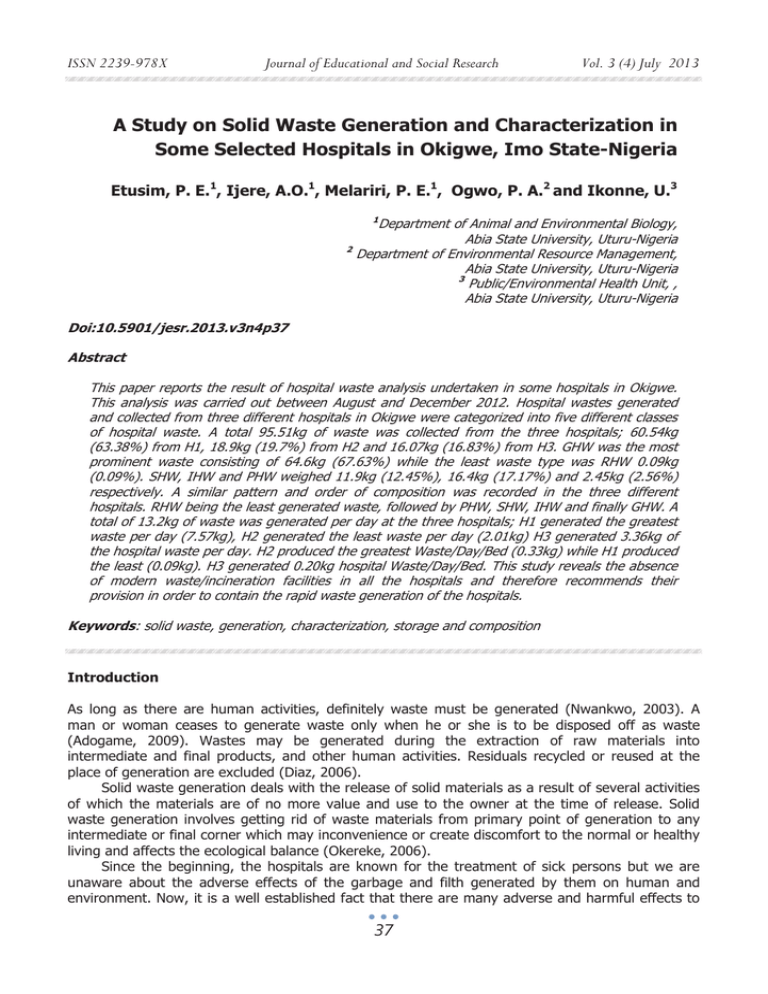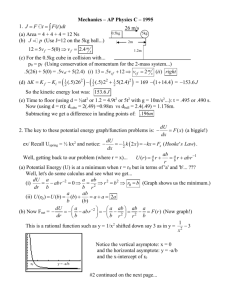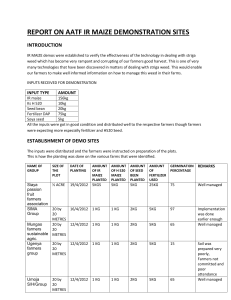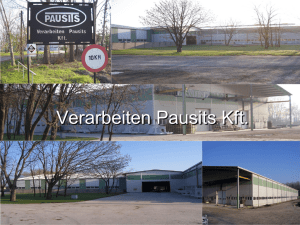Document 11650907
advertisement

ISSN 2239-978X Journal of Educational and Social Research Vol. 3 (4) July 2013 A Study on Solid Waste Generation and Characterization in Some Selected Hospitals in Okigwe, Imo State-Nigeria Etusim, P. E.1, Ijere, A.O.1, Melariri, P. E.1, Ogwo, P. A.2 and Ikonne, U.3 1 Department of Animal and Environmental Biology, Abia State University, Uturu-Nigeria 2 Department of Environmental Resource Management, Abia State University, Uturu-Nigeria 3 Public/Environmental Health Unit, , Abia State University, Uturu-Nigeria Doi:10.5901/jesr.2013.v3n4p37 Abstract This paper reports the result of hospital waste analysis undertaken in some hospitals in Okigwe. This analysis was carried out between August and December 2012. Hospital wastes generated and collected from three different hospitals in Okigwe were categorized into five different classes of hospital waste. A total 95.51kg of waste was collected from the three hospitals; 60.54kg (63.38%) from H1, 18.9kg (19.7%) from H2 and 16.07kg (16.83%) from H3. GHW was the most prominent waste consisting of 64.6kg (67.63%) while the least waste type was RHW 0.09kg (0.09%). SHW, IHW and PHW weighed 11.9kg (12.45%), 16.4kg (17.17%) and 2.45kg (2.56%) respectively. A similar pattern and order of composition was recorded in the three different hospitals. RHW being the least generated waste, followed by PHW, SHW, IHW and finally GHW. A total of 13.2kg of waste was generated per day at the three hospitals; H1 generated the greatest waste per day (7.57kg), H2 generated the least waste per day (2.01kg) H3 generated 3.36kg of the hospital waste per day. H2 produced the greatest Waste/Day/Bed (0.33kg) while H1 produced the least (0.09kg). H3 generated 0.20kg hospital Waste/Day/Bed. This study reveals the absence of modern waste/incineration facilities in all the hospitals and therefore recommends their provision in order to contain the rapid waste generation of the hospitals. Keywords: solid waste, generation, characterization, storage and composition Introduction As long as there are human activities, definitely waste must be generated (Nwankwo, 2003). A man or woman ceases to generate waste only when he or she is to be disposed off as waste (Adogame, 2009). Wastes may be generated during the extraction of raw materials into intermediate and final products, and other human activities. Residuals recycled or reused at the place of generation are excluded (Diaz, 2006). Solid waste generation deals with the release of solid materials as a result of several activities of which the materials are of no more value and use to the owner at the time of release. Solid waste generation involves getting rid of waste materials from primary point of generation to any intermediate or final corner which may inconvenience or create discomfort to the normal or healthy living and affects the ecological balance (Okereke, 2006). Since the beginning, the hospitals are known for the treatment of sick persons but we are unaware about the adverse effects of the garbage and filth generated by them on human and environment. Now, it is a well established fact that there are many adverse and harmful effects to 37 ISSN 2239-978X Journal of Educational and Social Research Vol. 3 (4) July 2013 the environment including human beings which are caused by the “Hospital Waste” generated during the patients care. Hospital waste is a potential health hazard to the health care workers, public and flora and fauna of the area (Chandra, 1999). Hospital generates a variety of different kinds of waste and refuse. Categorizing hospital waste helps staff keep hospitals clean and sanitary so that diseases and infections do not spread. Hospital waste is broken into five general categories, namely; GHW, SHW, IHW, PHW, RHW and each type of refuse is handled with the necessary precautions to help everyone maintain optimal health (Mackenzie and Crown-well, 1998). Methods MOBILIZATION: The medical directors of the selected hospitals were mobilized. The aims of the study and benefits to the establishment were well communicated to them. ON-SITE STORAGE: Four big dustbins (plastic) were placed at different points in each of the hospitals for gathering of all the hospital waste generated each day. WASTE COLLECTION: The wastes in the collection points were collected, characterized and weighed. Results A total of 95.51kg of waste was generated from the three hospitals; H1 generated the greatest waste of 60.54kg (63.38%) while H2 generated the least hospital waste of 16.07kg (16.83%) and H3 generating 18.9kg (19.7) of the hospital waste. The relative abundance of waste from the three hospitals followed the same pattern of relative composition. The least type of waste was RHW while GHW was the greatest waste. PHW, SHW and IHW recorded 2.45kg, 11.9kg and16.4kg respectively. GHW IHW SHW PHW RHW A total of 13.21kg of waste was generated per day at the three hospitals. H1 generated the greatest waste per day (7.57kg), H3 generated the least amount of waste (2.01kg) while H2 generated 3.36kg of hospital waste per day. H2 produced the greatest waste per day per bed (0.33kg) while H1 generated the least waste per day per bed (0.09kg) and H3 generated 0.20kg hospital waste per day per bed. A total waste of 60.54kg was generated during the period of the study at H1. GHW waste which was the greatest generated hospital waste weighed 40.6kg (67.1%) of the total generated waste, SHW or Sharps weighed 8.2kg making up 13.54% of the total generated waste, IHW weighed 10.2kg of the total waste making up 16.84% of the total generated waste, PHW weighed 1.5kg making up 2.5% of the total waste generated, RHW which was the least generated waste weighed 0.04kg making up 0.1% of the total generated waste. A total of 0.754kg of waste was generated per bed during the study period. The total hospital waste generated at H2 Okigwe weighed 18.9kg. GHW weighed 12.4kg making up 65.5% of the total generated waste, SHW weighed 2.2kg making up 11.64% of the total generated waste, IHW weighed 3.5kg making up 18.5% of the total generated waste, PHW waste weighed 0.68kg making up 3.6% of the total generated waste, and RHW weighed 0.02kg making up 0.1% of the total generated waste. The GHW constituted the greatest portion of the total hospital waste (12.4KG) generated at H2 while the least waste was constituted by RHW making up just a minute 0.02kg (0.1%) of the total generated waste. A total of 1.89kg of waste was generated per bed during the study period. 38 ISSN 2239-978X Journal of Educational and Social Research Vol. 3 (4) July 2013 The total hospital waste generated during the study at H3 weighed 16.07kg, GHW weighed 11.6kg making up 72.19% of the total generated waste, SHW weighed 1.5kg making up 9.33% of the total generated hospital waste, IHW weighed 2.7kg making up 16.80% of the total generated hospital waste, PHW weighed 0.27kg making up 1.68% of the total generated hospital waste and no RHO was generated during the study therefore RHW made up 0% of the total generated waste. The most predominant waste collected at H3 is the GHW, PHW made up the least generated waste while there was no RHW generated at the hospital during the study. A total 0f 1.636kg of waste was generated per bed during the period of the study at H3. Table 1: The Composition Of Waste Generated From Some Selected Hospitals In Okigwe L.G.A W.C GHW SHW IHW PHW RHW TW %W TW/D TW/D/B H1 40.6KG 8.2KG 10.2KG 1.5KG 0.04KG 60.54KG (63.38%) 7.57KG 0.09KG H2 12.4KG 2.2KG 3.5KG 0.68KG 0.02KG 18.9KG (19.7%) 3.36KG 0.33KG H3 11.6KG 1.5KG 2.7KG 0.27KG 16.07 (16.83) 2.01KG 0.20KG T.W 64.6KG 11.9KG 16.4KG 2.45KG 0.09KG 95.51 (100%) 13.21KG 0.62KG KEY: WC= Waste Classes H1= General Hospital Okigwe (Government owned) H2= Ivory Clinic Okigwe (private) H3= St. Mary’s Hospital Okigwe (private) TW= Total Weight GHW= General Hospital Waste SHW= Sharp Hospital Waste IHW= Infectious Hospital Waste PHW= Pharmaceutical Hospital Waste Radioactive Hospital Waste %w= Percentage Weight TW/D= Total Weight Per Day TW/D/B= Total Waste Per Day Per Bed. 70 60 50 40 30 20 10 0 H1 H2 Fig 1: Total Waste Generated At H1, H2, & H3 39 H3 ISSN 2239-978X Journal of Educational and Social Research Vol. 3 (4) July 2013 0,4 0,3 0,2 TOTAL WASTE PER DAY PER BED 0,1 0 H1 H2 H3 Fig 2: Total Waste Per Day Per Bed From H1, H2 & H3 Table 2: Composition Of Hospital Waste Generated At H1 Okigwe DAYS GHW SHW IHW PHW RHW TWD BED NO TW/D/B 1 2 3 4 5 6 7 8 TOTAL/ %W 3.8KG 4.9KG 4.7KG 5.4KG 4.8KG 5.8KG 5.6KG 5.6KG 40.6KG (67.1%) 0.8KG 1.0KG 1.3KG 0.8KG 1.2KG 1.2KG 1.1KG 0.8KG 8.2KG (13.54%) 1.1KG 1.4KG 1.2KG 1.2KG 1.4KG 1.5KG 1.3KG 1.1KG 10.2KG (16.84%) 0.2KG 0.3KG 0.1KG 0.2KG 0.1KG 0.3KG 0.1KG 0.2KG 1.5KG (2.5%) 0.03KG 0.01KG 0.04KG (0.1%) 5.9KG 7.6KG 7.3KG 7.6KG 7.5KG 8.8KG 8.1KG 7.7KG 60.5KG (100%) 80 80 80 80 80 80 80 80 80 0.073KG 0.095KG 0.091KG 0.095KG 0.093KG 0.110KG 0.101KG 0.096KG 0.754KG 45 40 35 30 25 20 15 10 5 0 GHW SHW IHW PHW Fig 3: Total Waste Generated at H1. 40 RHW ISSN 2239-978X Journal of Educational and Social Research Vol. 3 (4) July 2013 Table 3: Composition Of Hospital Waste Generated At H2 Okigwe DAYS GHW SHW IHW PHW RHW TW/D 1 2 3 4 5 6 7 8 TOTAL %W 0.4KG 1.8KG 1.7KG 1.6KG 1.9KG 1.5KG 1.6KG 1.9KG 12.4KG (65.6%) 0.1KG 0.3KG 0.4KG 0.3KG 0.4KG 0.3KG 0.2KG 0.2KG 2.2KG (11.6%) 0.3KG 0.4KG 0.5KG 0.6KG 0.5KG 0.5KG 0.3KG 0.4KG 3.5KG (18.5%) 0.05KG 0.05KG 0.4KG 0.02KG 0.04KG 0.01KG 0.01KG 0.1KG 0.68KG (3.6%) 0.01 0.01 0.02KG (0.1%) 0.95KG 2.55KG 3.0KG 2.53KG 2.85KG 2.31KG 2.11KG 2.6KG 18.9KG (100%) BED NO 10 10 10 10 10 10 10 10 10 TW/D/B 0.095KG 0.255KG 0.30KG 0.253KG 0.285KG 0.231KG 0.211KG 0.260KG 1.89KG 14 12 10 8 6 4 2 0 GHW SHW IHW PHW RHW Fig. 4: Total Waste Generated at H2. Table 4:Composition Of Hospital Waste Generated At H3 Okigwe DAYS GHW SHW IHW PHW RHW TW BED NO TW/D/B 1 2 3 4 5 6 7 8 TOTAL %W 0.3KG 1.7KG 1.6KG 1.5KG 1.8KG 1.4KG 1.5KG 1.8KG 11.6KG (72.19%) 0.1KG 0.2KG 0.3KG 0.2KG 0.3KG 0.2KG 0.1KG 0.1KG 1.5KG (9.33%) 0.2KG 0.3KG 0.4KG 0.5KG 0.4KG 0.2KG 0.3KG 0.3KG 2.7KG (16.80%) 0.04KG 0.04KG 0.03KG 0.01KG 0.03KG 0.01KG 0.1KG 0.1KG 0.27KG (1.68%) - 0.64KG 2.24KG 2.33KG 2.21KG 2.53KG 1.81KG 2.3KG 2.3KG 2.3KG (100%) 10 10 10 10 10 10 10 10 10 0.064KG 0.224KG 0.233KG 0.221KG 0.253KG 0.181KG 0.230KG 0.230KG 1.636KG 41 ISSN 2239-978X Journal of Educational and Social Research Vol. 3 (4) July 2013 14 12 10 8 6 4 2 0 GHW SHW IHW PHW RHW Fig. 5: Total Waste Generated At H3. Discussion The generation of a total of 95.51kg hospital waste in H1, H2 and H3 is of public health significance. Some of GHW are often burnt and therefore constitute some forms of air pollution around the hospitals. Others like the pathological wastes are infectious and could become veritable sources of infection while some others such as radioactive waste and sharps are hazardous. Healthcare activities are a means of protecting health, curing patients and saving lives. But they also generate waste, about 20% of which entails risks of infection, trauma or chemical or radiation exposure (Ogwueleka, 2003). Although the risk associated with hazardous medical waste and the way and means of managing that waste are relatively well known and described in manuals and other literatures, the treatment and elimination methods advocated require considerable technical and financial resources and a legal frame work, which are often lacking (Hayashi, 2006). In course of this study, it was observed that none of the hospitals studied had incineration capacity or access to other essential Health-Care Waste Management (HCWM) equipment. This observation is similar to the observation of Harhay et. al. (2009) who also noted the absence of incineration capacity or access to other essential HCWM among hospitals in Kabul. Different researchers have produced different statistics on the relative composition of hospital wastes; Basu (2004) in his study noted that infectious materials consist of 15% of hospital waste. This is similar to result of this study (17.35%) and to that of WHO (2011) which recorded infectious hospital waste also to be about 15% of a hospitals waste. According to Oke (2008) and WHO (2011), just about 1% of hospital’s waste is made of sharps; this differs from the result obtained from this study which recorded sharps to have an average of 11.49% of the total hospital waste. Sarma and Mathur (1998) recorded 3% of hospital’s waste to be pharmaceutical. This is similar to the result obtained from this study (2.59%) and to W.H.O (2011) which recorded pharmaceutical waste to be about 3%. Fluke (2006) and WHO (2001) recorded Radioactive Hospital Waste to be less than 1% of a hospital waste. This is higher than the result of this study (0.1%) Suess et. al. (2008) and WHO (2011) noted in their study that General Hospital Waste makes up about 80% of hospital waste. From the result obtained from this study, General Hospital Waste 42 ISSN 2239-978X Journal of Educational and Social Research Vol. 3 (4) July 2013 made up an average of 70.26% of the total hospital waste and this is less than Suess et. al. and WHO record. According to Jain and Aggarwal (1998) an ICRC hospital with 100 beds will produce an average of 1.5kg to 3kg of waste per patient per day. From this study, H1 with 80 beds recorded the least waste (0.76kg) per patient per bed, H2 with 10 beds recorded the greatest waste (1.89kg) per patient per bed, while H3 also with 10 beds recorded 1.64kg of waste per patient per bed. Although H1 recorded the greatest waste generated (60.54kg), it also recorded the least waste per bed. This may be because of the non-challant attitude of government workers, poor infrastructure etc. in the place that has discouraged admission cases. Poor waste management can jeopardize care staff, employees who handle medical waste, patients and their families, and the neighbouring population. In addition, the inappropriate treatment or disposal of that waste can lead to environmental contamination or pollution (Hayward, 2002). If the overall goal of waste management is to prevent disease transmission from waste products, therefore the emphasis should be placed more on the “management” aspect of the process and not on the “technological fix” which is an expensive diversion rather than an effective solution (Mahmood et. al., 2000). This study shows the characterization of the hospital waste since the composition must be well known especially by the hospital authorities for decision making and planning. References Adogame, L. (2009). “Towards Enhanced Public-Private Partnership in Solid Waste Management in Lagos State”, Paper presented at the Workshop on effective solid waste management, Lagos Airport Hotel, Ikeja, Nigeria, August. Basu, R. N. (2004). Issues involved in hospital waste management: an experience from a large teaching institution. J Acad Hosp Adm; 8: 79-86. Chandra, H. (1999). Conference on world environmental day;Journal of Hospital Waste, an Environmental Hazard and its Management 10(5) 15-20. Diaz, L. F. (2006). Solid Waste Management, volume 2. UNEP/Earthpoint. Fluke, C. (2006). Handling hazardous waste. J Health Mater Manager; 6: 70-3. Harhay, M. O., D. S. Halpern, J. S. Harhay and O. L. Piero (2009). Health Care Waste Management: a neglected and growingpublic health problem worldwide. Journal of Tropical Medicine and International Health vol14: 1-4 Hayashi, Y. (2006). Proper disposal of medical wastes – infection,prevention and waste management at Hiroshima City, Asa Hospital, Risho Byori, 2000 (suppl 112) pp. 26-31. Hayward, E. (2002). The ethical responsibility of the hospital to the environment. J Health Mater Manager; 14: 19-27. Jain, T. P. and R. Aggarwal (1998). Hospital Waste Management – A holistic view. Proceedings of National Workshop as management of hospital waste. Mackenzie, L. D. and A. D. Crown-Well (1998). Introduction to Environmental Engineering, 3rd Edition, United States. Mahmood, M., S. Sharab, R. Malik and W. Azim (2000). A study of waste generation, collection and disposal in a tertiary hospital. Pak J Med Res; 40: 13-17. Nwankwo, B. O. (2003). Occupational health and industrial hygiene: Concepts and principles. Owerri: Concave publishers; 140pp. Oke, I. A. (2008). Management of immunization solid wastes in Kano State, Nigeria. Waste Management 28, 2512–2521. Okereke, J. C. (2006). “Environmental Pollution and Control”. The Environmental Health Journal 10: 125-130. Sarma, R. K. and S. K. Mathur (1998). Management of Hospital Waste, Journal of Academy of Hospital Administration, 1(2), 55-7. Suess, M. J., J. W. Huisman and T. P. Jain (2008). Legal and administrative requirements in management of Hazardous Waste, WHO Regional Publication NO. 14, 25-35. World Health Organisation (2011). Waste from health-care activities. Report of W.H.O expert committee. Volume 253 43








